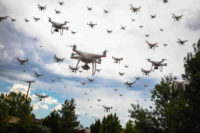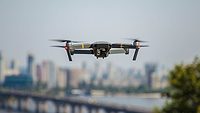Commercial and military drones in Ukraine: The evolutionary use and implications on security and safety

There has been a tremendous amount of reporting on drones and the Ukraine war but a real lack of reporting from the ground perspective. Recently, coverage on capability and effects from the ground point of view has emerged, and the information is insightful and valuable. Elements of Ukrainian Special Forces have been causing havoc on Russian Motorized Rifle formations. The Russian advantage in terms of the “principle of mass” is clearly there, but unconventional warfare is proving to be the creative factor generating ground parity for the Ukrainian effort.
Textbook small unit operations and “hit and move” techniques have shown to be highly successful, especially with the right anti-tank and armor weapons. But what about drones? How are these platforms changing the landscape in what has become a target-rich environment? And how does this shape our future security environment in areas outside of conflict zones?
The desire and tactical need for a portable drone platform with extended range, battery life, and customized payload are clear from the ground perspective. The primary issue is supply, type of platform and quantity. The use of commercial drones is routine on both sides of the conflict. We are inundated daily with news reporting on the application and use of these platforms, proving the importance of the technology on the battlefield. Technology is not a replacement for other battlefield realities but a tool that is seeing evolutionary use to support ground and air parity. In reality, all units are equipped with a platform, even down to individual tank crews and squads. This tells the story of the importance of easily deployable drone systems and the creativity associated with getting them into the fight.
Overall, the effectiveness of these tools has been based on the circumstances and the environment. One specific item of note is the ease of geo-locating commercial drone operators. This is a crucial lesson learned and makes the operator vulnerable as a target in a fast-paced conflict with modern detection capability.
So how does this relate to security and safety in the homeland?
Technologies continue to evolve in the form of lightweight, man-portable, quickly deployable systems. Equipment that can go in a soldier’s rucksack or a person’s backpack has the potential to provide high-end capability options with customized payloads is now a reality. Look at recent reports from Teledyne FLIR on emerging capability on what is possible. Additionally, drone platforms available for commercial purchase come “out of the box,” ready for myriad payload options. Still, they are highly trackable by drone detection systems that can geo-locate the operator. Since this is the only legal response option based on current FAA regulations and legislation, this type of system could be valuable to a business or venue interested in lowering the drone threat. Note: this is not the case for designated critical infrastructure and events with high-level visibility.
The experimentation with drone warfare in Ukraine has opened our eyes to what is possible with easily accessible platforms. Technology tested in conflict can — and will — eventually make its way to the homeland both for positive and negative purposes, and we must be mindful and prepared. USG and security professionals from all agencies and businesses are woefully behind on what can be done from a legal perspective and what should be done from a planning perspective. Two over-the-horizon ideas that are still in development are unmanned traffic management (UTM) in Europe, commonly known as U-Space. U-Space is a system to monitor the future “drone superhighway,” similar to how the Federal Aviation Administration (FAA) monitors commercial air traffic.
The second is the urban air mobility (UAM) program — think unmanned taxis and delivery platforms. UAM is the next wave of moving people and goods in unmanned autonomous platforms. While these programs are still in development, a simple solution can significantly impact drone security: innovative urban planning. Urban planners need to consider the rapidly changing pace of society as it pertains to this technology. Security consultants should play a vital role on design teams from the early stages. If we don’t plan for drones in future design, the cost will rise immensely to retrofit vital security features.
As the war in Ukraine continues, so does the experimentation with commercial drones in a high-intensity conflict. The Modern War Institute recently published a piece on seven lessons learned regarding drones and the Ukraine war. This article is an insightful piece about the air parity between combatants. A convergence of commercial and military drones is reshaping air space conditions.
The merging of military-designed unmanned aerial vehicles (UAV) and unmanned aerial systems (UAS) with commercial off-the-shelf (COTS) drone technology is simply mind-boggling. It’s making a significant impact as Ukrainians leverage every available tool to defend their homeland and fight off the Russian superpower. As the Western world continues to slowly move military supplies into Ukraine, so do private companies willing to help the war effort. The drone war is only beginning to heat up as Ukrainian creativity and innovation have proven effective and deadly.
We’ve recently seen advanced technology like the Switchblade and Phoenix Ghost platforms join the fight, giving the Ukrainians quick-strike capability. But we’ve also seen many COTS products utilized for intelligence, surveillance, reconnaissance (ISR), and targeting, typically seen in higher-end platforms but are now easily used by employing recreational platforms with video payloads.
So why is this important? This merger of military-grade and COTS is a new approach when it comes to full employment of drones and robotics in conflict, specifically in Ukraine. As the war continues, it gives governments and private businesses a place to test their products under wartime conditions. This ultimate laboratory environment puts the systems through high-stress environments and helps to prove the technology.
So, how can we apply these lessons to security in the private sector?
- Understand that drone and robotic technologies are now solidly part of the fabric of modern society. They are not going away.
- What is tested and used in conflict zones will eventually make its way to the homeland. Security professionals need to understand the capability and the threat. Conduct a Drone Vulnerability and Risk Assessment (DVRA).
- Face Reality. Security professionals from all market sectors need to understand the risks. Security program development should include assessment and mitigation options as it pertains to commercial drones.
- Understand your operating environment. If you host the public at your venue or event, take prudent measures to step up security. Conduct a DVRA, survey your airspace for pattern of life cycles, conduct Drone Emergency Response Planning (DERP), solidify policies and procedures into standard operating procedures, and train, rehearse responses, and exercise potential incidents.
- Don’t sit idle waiting for a drone event to happen. Take steps to mitigate the risk associated with this technology. Waiting for a catastrophe is a poor course of action choice.
The Ukraine war has given us an open window into the possibilities of drones in combat. But more importantly, it has shown security professionals the reality of this evolving technology and what is on the horizon from a threat perspective. This technology needs to be studied, understood, and proactively planned for. Commercial drone technology has made considerable advances in the last decade and has “crept” upon the security and safety landscape. Let’s keep the conversation going!
Looking for a reprint of this article?
From high-res PDFs to custom plaques, order your copy today!






